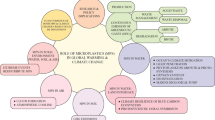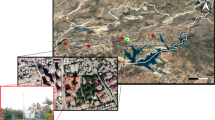Abstract
Concentrations of airborne particulate matter with a diameter ≤ 10 µm (PM10) strongly affect local, regional, and global environments, human activities, and human health. The Yarlung Zangbo River in the southern Tibet Plateau creates a serious dust hazard, but there are few detailed field measurements of this region’s PM10 emission. To provide more information, we used a laser particle counter to measure PM10 concentrations above grassland floodplains, floodplains with a physical crust, shifting dunes, and shifting sand stabilized by planted trees. We used data from 9 days with a strong dust storm (between February and May 2021) to quantify spatial and temporal differences of PM10 concentration and the effect of meteorological conditions on emission and transport. The daily mean PM10 concentration ranged from 26.9 to 253.3 µg m−3 for a mean wind velocity ranging from 2.1 to 9.7 m s−1, and a maximum wind velocity ranging from 4.6 to 14.7 m s−1. Mean hourly PM10 can reach 800 µg m−3, and hourly wind velocity, air temperature, relative humidity, and soil temperature all affect PM10, but their effects vary spatially. The hourly mean PM10 concentration increased with increasing mean hourly wind velocity above the shifting sand surface, but we found no significant relationships at the floodplain sites. The hourly mean PM10 reached its maximum at a relative humidity of about 30%, with air temperature and soil temperature about 8 °C. Therefore, forecasting dust storms in the Yarlung Zangbo River basin will require knowledge of the land surface characteristics and the critical values of relative humidity and of air and soil temperatures.









Similar content being viewed by others
Data availability
All data in the present study are available by contacting Prof. Zhengcai Zhang (zhangzhsi@lzb.ac.cn).
Code availability
Not applicable.
References
Argaman E, Singer A, Tsoar H (2006) Erodibility of some crust forming soils/sediments from the southern Aral Sea Basin as determined in a wind tunnel. Earth Surf Proc Land 31:47–63
Barnum BH, Winstead NS, Wesely J, Hakola A, Colarco PR, Toon OB, Ginoux P, Brooks G, Hasselbarth L, Toth B (2004) Forecasting dust storms using the CARMA-dust model and MM5 weather data. Environ Modell Softw 19:129–140
Belnap J, Gillette DA (1998) Vulnerability of desert biological crusts to wind erosion: the influences of crust development, soil texture, and disturbance. J Arid Environ 39:133–142
Belnap J, Walker BJ, Munson SM, Gill RA (2014) Controls on sediment production in two U.S. deserts. Aeolian Res 14:15–24
Bullard JE, Baddock MC, Bradwell T, Crusius J, Darlington E, Gaiero D, Gasso S, Gisladottir G, Hodgkins R, McCulloch R, McKenna-Neuman C, Mockford T, Steward H, Thorsteinsson T (2016) High-latitude dust in the Earth system. Rev Geophys 54:447–485
Burri K, Gromke C, Lehninga M, Graf F (2011) Aeolian sediment transport over vegetation canopies: a wind tunnel study with live plants. Aeolian Res 3:205–213
Chen SY, Jiang NX, Huang JP, Zang Z, Guan XD, Ma XJ, Luo Y, Li JM, Zhang XR, Zhang YT (2019) Estimations of indirect and direct anthropogenic dust emission at the global scale. Atmos Environ 200:50–60
Cong ZY, Kang SC, Luo CL, Li Q, Huang J, Gao SP, Li XD (2011) Trace elements and lead isotopic composition of PM10 in Lhasa. Tibet Atmos Environ 45(34):6210–6215
Csavina J, Field J, Félix O, Corral-Avitia AY, Sáez AE, Betterton EA (2014) Effect of wind speed and relative humidity on atmospheric dust concentrations in semi-arid climates. Sci Total Environ 487:82–90
Cui MC, Lu HY, Wiggs GFS, Etyemezian V, Sweeney MR, Xu ZW (2019) Quantifying the effect of geomorphology on aeolian dust emission potential in northern China. Earth Surf Proc Land 44:2872–2884
Dansie AP, Wiggs GFS, Thomas DS, Washington GR (2017) Measurements of windblown dust characteristics and ocean fertilization potential: the ephemeral river valleys of Namibia. Aeolian Res 29:30–41
Dong ZB, Hu GY, Qian GQ, Lu JF, Zhang ZC, Luo WY, Lyu P (2017) High-altitude Aeolian research on the Tibetan Plateau. Rev Geophys 55:864–901
Duce RA, Unni CK, Ray BJ, Prospero JM, Merrill JT (1980) Long-range atmospheric transport of soil dust from Aia to the Tropical North Pacific: temporal variability. Science 209:1522–1524
Filonchyk M, Yan H, Hurynovich V (2017) Temporal-spatial variations of air pollutants in Lanzhou, Gansu Province, China, during the spring-summer periods, 2014–2016. Environ Qual Manage 26:65–74
Fryberger G S, Dean G (1979) Dune forms and wind regime. In: McKee E D. (ed.) A Study of Global Sand Seas. Washington,USA: US Government Printing Office
Ginoux P, Garbuzov D, Hsu NC (2010) Identification of anthropogenic and natural dust sources using Moderate Resolution Imaging Spectroradiometer (MODIS) Deep Blue level 2 data. J Geophys Res 115:D05204
Guan QY, Yang J, Zhao S, Pan B, Liu C, Zhang D, Wu T (2015) Climatological analysis of dust storms in the area surrounding the Tengger Desert during 1960–2007. Clim Dyn 45(3–4):903–913
Guan QY, Sun X, Yang J, Pan B, Zhao S, Wang L (2017) Dust storms in northern China: long-term spatiotemporal characteristics and climate controls. J Clim 30(17):6683–6700
Guan QY, Luo HP, Pan NH, Zhao R, Yang LQ, Yang YY, Tian J (2019) Contribution of dust in northern China to PM10 concentrations over the Hexi corridor. Sci Total Environ 660:947–958
Jickells T, An Z, Andersen KK, Baker A, Bergametti G, Brooks N, Cao J, Boyd P, Duce R, Hunter K (2005) Global iron connections between desert dust, ocean biogeochemistry, and climate. Science 308(5718):67–71
Jugder D, Shinoda M, Kimura R, Batbold A, Amarjargal D (2014) Quantitative analysis on windblown dust concentrations of PM10 (PM2.5) during dust events in Mongolia. Aeolian Res 14:3–13
Kang LT, Huang JP, Chen SY, Wang X (2016) Long-term trends of dust events over Tibetan Plateau during 1961–2010. Atmos Environ 125:188–198
Kok JF, Adebiyi AA, Albani S, Balkanski Y, Checa-Garcia R, Chin M, Colarco PR, Hamilton DS, Huang Y, Ito A, Klose M, Li L, Mahowald NM, Miller RL, Obiso V, Pérez García-Pando C, Rocha-Lima A, Wan JS (2021) Contribution of the world’s main dust source regions to the global cycle of desert dust. Atmos Chem Phys 21:8169–8193
Ma PF, Zhang ZC, Lunzhu QP, Gao JJ, Dai R, Wang C, Pan KJ (2021) Analysis on the sand transport wind power conditions and suggestions on the sand disaster preventions in the middle reaches of Yarlung Zangbo River, China. J Desert Res 41:10–18 ((in Chinese with English abstract))
Macpherson T, Nickling WG, Gillies JA, Etyemezian V (2008) Dust emissions from undisturbed and disturbed supply-limited desert surfaces. J Geophys Res, 113:F02S04
Martin RL, Kok JF (2017) Wind-invariant saltation heights imply linear scaling of aeolian saltation flux with shear stress. Sci Adv 3(6):e1602569
Neuman CM, Sanderson S (2008) Humidity control of particle emissions in aeolian systems. J Geophys Res Earth Surf 113:F2
Ravi S, Zobeck TM, Over TM, Okin GS, D’Odorico P (2006) On the effect of moisture bonding forces in air-dry soils on threshold friction velocity of wind erosion. Sedimentology 53:597–609
Shao Y, Raupach MR (1993) Effect of saltation bombardment on the entrainment of dust by wind. J Geophys Res-Atmos 98(D7):12719–12726
Shao Y, Fink AH, Klose M (2010) Numerical simulation of a continental-scale Saharan dust event. J Geophys Res 115:D13205
Sharratt B, Pi H (2018) Field and laboratory comparison of PM10 instruments in high winds. Aeolian Res 32:42–52
Sharratt BS, Vaddella V (2014) Threshold friction velocity of crusted windblown soils in the Columbia Plateau. Aeolian Res 15:227–234
Shen YP, Zhang CL, Wang RD, Wang XS, Cen SB, Li Q (2020) Spatial heterogeneity of surface sediment grain size and aeolian activity in the gobi desert region of northwest China. CATENA 188:104469
Sun JM, Li SH, Muhs DR, Li B (2007) Loess sedimentation in Tibet: provenance, processes, and link with Quaternary glaciations. Quat Sci Rev 26:2265–2280
Sweeney MR, McDonald EV, Etyemezian V (2011) Quantifying dust emissions from desert landforms, eastern Mojave Desert, USA. Geomorphology 135(1–2):21–34
Tatarko J, Matthew K, Li HL, Li HR (2020) PM2.5 and PM10 emissions by abrasion of agricultural soils. Sci Total Environ 200:104601
Van Pelt RS, Baddock MC, Zobeck TM, d’Odorico P, Ravi S, Bhattachan A (2017) Total vertical sediment flux and PM10 emissions from disturbed Chihuahuan Desert surfaces. Geoderma 293:19–25
Wang JK, Gui HL, An LC, Hua C, Zhang TH, Zhang BH (2021) Modeling for the source apportionments of PM10 during sand and dust storms over East Asia in 2020. Atmos Environ 267:118768
WHO - World Health Organization (1995) Updating and Revision of the Air Quality Guideline for Europe. EUR/ICP/EHAZ 94 05/PB01. Meeting of the Working Group "Classical" Air Pollutants. World Health Organization Regional Office for Europe.
Wolfe SA, Nickling WG (1993) The protective role of sparse vegetation in wind erosion. Progr Phys Geogr 17(1):50–68
Yang JH, Xia DS, Gao FY, Wang SY, Li DX, Fan YJ, Chen ZX, Tian WD, Liu XY, Sun XY, Wang ZQ, Wang F (2021) Holocene moisture evolution and its response to atmospheric circulation recorded by aeolian deposits in the southern Tibetan Plateau. Quat Sci Rev 270:107169
Yin XF, Foy B, Wu KP, Feng C, Kang SC, Zhang GQ (2019) Gaseous and particulate pollutants in Lhasa, Tibet during 2013–2017: spatial variability, temporal variations and implications. Environ Pollut 253:68–77
Zhang XY, Gong SL, Zhao TL, Arimoto R, Wang YQ, Zhou ZJ (2003) Sources of Asian dust and role of climate change versus desertification in Asian dust emission. Geophys Res Lett 30:2272
Zhang ZC, Dong ZB, Zhao AG (2008) The effect of restored microbiotic crusts on erosion of soil from a desert area in China. J Arid Environ 7:710–721
Zhang Y, Ma PF, Zeng L, Liang AM, Zhang ZC (2021) Study on silt and clay provenance in the Yarlung Zangbo River middle reaches using sediment physicochemical characteristics. J Desert Res 43:92–100 ((in Chinese with English abstract))
Zhang ZC, Zhang Y, Ma PF, Za D (2022) Aeolian sediment transport rates in the middle reaches of the Yarlung Zangbo River, Tibet Plateau. Sci Total Environ 826:154238
Acknowledgements
We are grateful for the financial assistance we obtained from the Project for Establishing a Sand-dust Monitoring and Forecast System for the North-bank Settlement Area of the Yarlung Zangbo River (under the 13th Five-year Plan of the Tibet Autonomous Region), and from the Chinese Academy of Sciences Interdisciplinary Innovation Team.
Funding
This work was supported by Chinese Academy of Sciences Interdisciplinary Innovation Team and the Project for Establishing a Sand-dust Monitoring and Forecast System for the North-bank Settlement Area of the Yarlung Zangbo River (under the 13th Five-year Plan of the Tibet Autonomous Region).
Author information
Authors and Affiliations
Corresponding author
Ethics declarations
Ethics approval
Not applicable.
Consent to participate
Not applicable.
Consent for publication
Not applicable.
Competing interests
The authors declare no competing interests.
Additional information
Publisher's Note
Springer Nature remains neutral with regard to jurisdictional claims in published maps and institutional affiliations.
Supplementary Information
Below is the link to the electronic supplementary material.
Rights and permissions
Springer Nature or its licensor (e.g. a society or other partner) holds exclusive rights to this article under a publishing agreement with the author(s) or other rightsholder(s); author self-archiving of the accepted manuscript version of this article is solely governed by the terms of such publishing agreement and applicable law.
About this article
Cite this article
Ma, P., Zhang, Z., Zhang, Y. et al. Effect of meteorological conditions on PM10 concentrations in the middle reaches of the Yarlung Zangbo River, Tibet Plateau. Theor Appl Climatol 151, 725–737 (2023). https://doi.org/10.1007/s00704-022-04330-y
Received:
Accepted:
Published:
Issue Date:
DOI: https://doi.org/10.1007/s00704-022-04330-y




